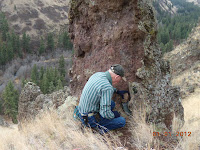My sisters didn’t argue with me when I said I would like
to have Mother’s collection of vintage magazines, and I couldn’t believe they
weren’t interested. The seeds of my love for these old ideas were sown in
childhood, though I didn’t realize the depth of my love. I didn’t even realize that I was
becoming a collector of works on vintage homemaking arts as I carried boxes of needlework and specialty magazines from the old family home.
I don’t think my mother considered herself a collector of
vintage magazines. She just bought what she liked – and kept it. But – she was
definitely a collector of vintage booklets. I am following in her footsteps and am indebted to her for her foresight. She
would laugh if she knew.
As I moved into retirement, I found myself wanting more
of these vintage ideas. I began to selectively invest in an old book here, a
magazine there.
A few years ago, I ordered a vintage pattern from an
online seller, and she included an unexpected bonus in the package – three issues of “Modern Priscilla.” It was
very generous of her, I thought, and some months later she passed away. I
couldn’t help but wonder if she was deliberately reducing her stock by giving
some things away.

Anyway, “Modern Priscilla” was a homemaking and handwork
magazine published from 1887 until 1930. (The publisher lost out in the Great Depression.)
As I glanced through the January 1926 issue last week, I noticed an ad for
“Clark’s O.N.T. Bag Book – 100 Designs for 10 Cents” for those who crochet and
embroider. Buy from your dealer, read the ad, or send ten cents to the
listed address and we’ll mail you a copy.
My curiosity immediately piqued, I searched for this
pattern booklet online. Yes! I could have it for $10.00 plus shipping, and I
had to have it! It came today, brightening a day when other plans had fallen
through. I’m delighted with it.
Who knew they were making all these bags in 1925? Here
are some of the categories:
Attractive Bags for the Business Woman
When Puzzled What to Give, Give a Bag
Afternoon Dress-up Bags that have Particular Charm

Laundry Bags that are Different
The Popular Utility Shopping Bag
The Kiddies Need Pretty Bags, Too
Gift Bags, Practical Bags, Bags of Great Beauty
Unusual Evening and Theatre Bags
For Hiking, Travel and School
Stunning Bags for Varied Uses
Work Bags Both Serviceable and Decorative
Bags for Household Use
Practical Shopping Bags and Hand Bags
Of course, some of the bags relate to obsolete uses. For
example, I don’t need a bag for my corsets, a hiking knapsack that won’t hold a
water bottle, or a laundry bag for my soiled collars. But, when it comes right
down to it, a bag’s a bag. The crocheted briefcase looks for all the world like
a laptop case. Evening bags are always useful. Unique handbags are in vogue
again. And, of course, there’s the re-usable shopping bag.
I just might surprise everyone someday and make one or
two of these bags. Until then – fascinating to look through this booklet. KW
 Here in our remote rural communities we have a wonderful
library system – Valnet. Lewiston, Clarkston, Moscow, and the smaller surrounding
communities are all part of one system, so we can check out books in Orofino or
Nezperce, for example, and then return them at the Asotin County Library or any
other member library. I understand that this system is a prototype that
libraries throughout the nation are watching, and our library administration
says it works very well.
Here in our remote rural communities we have a wonderful
library system – Valnet. Lewiston, Clarkston, Moscow, and the smaller surrounding
communities are all part of one system, so we can check out books in Orofino or
Nezperce, for example, and then return them at the Asotin County Library or any
other member library. I understand that this system is a prototype that
libraries throughout the nation are watching, and our library administration
says it works very well. First she checked the Valnet system, but my prediction
was correct -- she didn’t find it. Next she checked libraries at the University
of Idaho, Washington State University, and Gonzaga. Then she broadened the
search to Washington cities and found a copy at the Seattle Public Library. She
said that she didn’t anticipate any problems with the inter-library loan. Delivery
took about two weeks.
First she checked the Valnet system, but my prediction
was correct -- she didn’t find it. Next she checked libraries at the University
of Idaho, Washington State University, and Gonzaga. Then she broadened the
search to Washington cities and found a copy at the Seattle Public Library. She
said that she didn’t anticipate any problems with the inter-library loan. Delivery
took about two weeks. Electronic devices are now changing our library systems.
In fact, hands-on workshops to demonstrate the new technology occurred last
week at our libraries. The way we read is changing. It won’t happen overnight,
though. Some books might never be digitized. Perhaps Heavenly Days! is
an example. KW
Electronic devices are now changing our library systems.
In fact, hands-on workshops to demonstrate the new technology occurred last
week at our libraries. The way we read is changing. It won’t happen overnight,
though. Some books might never be digitized. Perhaps Heavenly Days! is
an example. KW































